Potential Impacts of Future Climate Change on Super-Typhoons in the Western North Pacific: Cloud-Resolving Case Studies Using Pseudo-Global Warming Experiments
Abstract
:1. Introduction
2. Data, Methodology, and Model Experiments
2.1. Data
2.2. Estimation of Long-Term Climate Change
2.3. Cloud-Resolving Model and Experiments
2.4. Water Budget Analysis
3. Projected Long-Term Trend of Climate Change
4. Overall Results of Control Experiments
5. Potential Impacts of Future Climate Change on Intense Typhoons
5.1. Track and Intensity
5.2. Precipitation
5.3. Water Budget Analysis
6. Discussion
7. Conclusions and Summary
Author Contributions
Funding
Institutional Review Board Statement
Informed Consent Statement
Data Availability Statement
Acknowledgments
Conflicts of Interest
References
- IPCC. Climate Change 2013: The Physical Science Basis. Contribution of Working Group I to the Fifth Assessment Report of the Intergovernmental Panel on Climate Change; Stocker, T.F., Qin, G.-K., Plattner, M., Tignor, S.K., Allen, J., Boschung, A., Nauels, Y., Xia, V., Bex, Midgley, P.M., Eds.; Cambridge University Press: Cambridge, UK; New York, NY, USA, 2013; p. 1535. [Google Scholar]
- IPCC. Climate Change 2021: The Physical Science Basis. Contribution of Working Group I to the Sixth Assessment Report of the Intergovernmental Panel on Climate Change; Masson-Delmotte, V., Zhai, P., Pirani, A., Connors, S.L., Péan, C., Berger, S., Caud, N., Chen, Y., Goldfarb, L., Gomis, M.I., et al., Eds.; Cambridge University Press: Cambridge, UK; New York, NY, USA, 2021; in press. [Google Scholar] [CrossRef]
- IPCC. 2018: Global Warming of 1.5 °C. An IPCC Special Report on the Impacts of Global Warming of 1.5 °C above Pre-Industrial Levels and Related Global Greenhouse Gas Emission Pathways, in the Context of Strengthening the Global Response to the Threat of Climate Change, Sustainable Development, and Efforts to Eradicate Poverty; Masson-Delmotte, V., Zhai, P., Pörtner, H.O., Roberts, D., Skea, J., Shukla, P.R., Pirani, A., Moufouma-Okia, W., Péan, C., Pidcock, R., et al., Eds.; in press; Available online: https://www.ipcc.ch/sr15/ (accessed on 25 March 2020).
- Neumann, C.J. A Global Tropical Cyclone Climatology. Global Guide to Tropical Cyclone Forecasting WMO-No. 1194; World Meteorological Organization (WMO): Geneva, Switzerland, 2017; pp. 28–62. Available online: https://cyclone.wmo.int/ (accessed on 18 August 2020).
- Li, Y.; Tang, Y.; Li, X.; Song, X.; Wang, Q. 2023: Recent increase in the potential threat of western North Pacific tropical cyclones. Npj Clim. Atmos. Sci. 2023, 6, 53. [Google Scholar] [CrossRef]
- Normile, D. After the Deluge. Science 2014, 344, 355–357. [Google Scholar] [CrossRef] [PubMed]
- Shimada, U.; Kubota, H.; Yamada, H.; Cayanan, E.O.; Hilario, F.D. Intensity and inner-core structure of Typhoon Haiyan (2013) near landfall: Doppler radar analysis. Mon. Weather Rev. 2018, 146, 583–597. [Google Scholar] [CrossRef]
- Normile, D. Deadly typhoon forces Japan to face its vulnerability to increasingly powerful storms. Science 2019. [Google Scholar] [CrossRef]
- Knutson, T.R.; McBride, C.J.; Emanuel, K.; Holland, G.; Landsea, C.; Held, I.; Kossin, J.P.; Srivastava, A.K.; Sugi, M. Tropical cyclones and climate change. Nat. Geosci. 2010, 3, 157–163. [Google Scholar] [CrossRef]
- Emanuel, K.A. Increasing destructiveness of tropical cyclones over the past 30 years. Nature 2005, 436, 686–688. [Google Scholar] [CrossRef]
- Knutson, T.R.; Sirutis, J.J.; Zhao, M.; Tuleya, R.E.; Bender, M.; Vecchi, G.A.; Villarini, G.; Chavas, D. Global projections of intense Tropical cyclone activity for the late twenty-first century from dynamical downscaling of CMIP5/RCP4.5 scenarios. J. Clim. 2015, 28, 7203–7224. [Google Scholar] [CrossRef]
- Tsou, C.-H.; Huang, P.-Y.; Tu, C.-Y.; Chen, C.-T.; Tzeng, T.-P.; Cheng, C.-T. Present simulation and future typhoon activity projection over western North Pacific and Taiwan/east coast of China in 20-km HiRAM climate model. Terr. Atmos. Ocean. Sci. 2016, 27, 687–703. [Google Scholar] [CrossRef]
- Bacmeister, J.T.; Reed, K.A.; Hannay, C.; Lawrence, P.; Bates, S.; Truesdale, J.E.; Rosenbloom, N.; Levy, M. Projected changes in tropical cyclone activity under future warming scenarios using a high-resolution climate model. Clim. Chang. 2018, 146, 547–560. [Google Scholar] [CrossRef]
- Knutson, T.; Camargo, S.J.; Chan, J.C.L.; Emanuel, K.; Ho, C.-H.; Kossin, J.; Mohapatra, M.; Satoh, M.; Sugi, M.; Walsh, K.; et al. Tropical cyclones and climate change assessment: Part II: Projected response to anthropogenic warming. Bull. Amer. Meteor. Soc. 2020, 101, E303–E322. [Google Scholar] [CrossRef]
- Knutson, T.R.; Sirutis, J.J.; Garner, S.T.; Vecchi, G.A.; Held, I.M. Simulated reduction in Atlantic hurricane frequency under twenty-first-century warming conditions. Nat. Geosci. 2008, 1, 359–364. [Google Scholar] [CrossRef]
- Allan, R.P.; Soden, B.J. Atmospheric warming and the amplification of precipitation extremes. Science 2008, 321, 1481–1484. [Google Scholar] [CrossRef] [PubMed]
- Alexander, L.A.; Tebaldi, C. Climate and Weather Extremes: Observations, Modeling and Projections. In The Future of the World’s Climate; Henderson-Sellers, A., McGuffie, K., Eds.; Elsevier: Amsterdam, The Netherlands, 2011; pp. 253–288. [Google Scholar]
- Emanuel, K.A. Downscaling CMIP5 climate models shows increased tropical cyclone activity over the 21st century. Proc. Natl. Acad. Sci. USA 2013, 110, 12219–12224. [Google Scholar] [CrossRef] [PubMed]
- Knutson, T.R.; Sirutis, J.J.; Vecchi, G.A.; Garner, S.; Zhao, M.; Kim, H.S.; Bender, M.; Tuleya, R.E.; Held, I.M.; Villarini, G. Dynamical downscaling projections of twenty-first-century Atlantic hurricane activity: CMIP3 and CMIP5 model-based scenarios. J. Clim. 2013, 26, 6591–6617. [Google Scholar] [CrossRef]
- Davis, C.A. Resolving tropical cyclone intensity in models. Geophys. Res. Lett. 2018, 45, 2082–2087. [Google Scholar] [CrossRef]
- Murakami, H.; Wang, Y.; Yoshimura, H.; Mizuta, R.; Sugi, M.; Shindo, E.; Adachi, Y.; Yukimoto, S.; Hosaka, M.; Kusunoki, S.; et al. Future changes in tropical cyclone activity projected by the new high-resolution MRI-AGCM. J. Clim. 2012, 25, 3237–3260. [Google Scholar] [CrossRef]
- Sillmann, J.; Kharin, V.V.; Zwiers, F.W.; Zhang, X.; Bronaugh, D. Climate extremes indices in the CMIP5 multimodel ensemble: Part 2. Future climate projections. J. Geophys. Res. Atmos. 2013, 118, 2473–2493. [Google Scholar] [CrossRef]
- Scoccimarro, E.; Gualdi, S.; Villarini, G.; Vecchi, G.A.; Zhao, M.; Walsh, K.; Navarra, A. Intense precipitation events associated with landfalling tropical cyclones in response to a warmer climate and increased CO2. J. Clim. 2014, 27, 4642–4654. [Google Scholar] [CrossRef]
- Stott, P.A.; Gillett, N.P.; Hegerl, G.C.; Karoly, D.J.; Stone, D.A.; Zhang, X.; Zwiers, F. Detection and attribution of climate change: A regional perspective. Wiley Interdiscip. Rev. Clim. Chang. 2010, 1, 192–211. [Google Scholar] [CrossRef]
- Tsuboki, K.; Yoshioka, M.K.; Shinoda, T.; Kato, M.; Kanada, S.; Kitoh, A. Future increase of super typhoon intensity associated with climate change. Geophys. Res. Lett. 2015, 42, 646–652. [Google Scholar] [CrossRef]
- Mizuta, R.; Oouchi, K.; Yoshimura, H.; Noda, A.; Katayama, K.; Yukimoto, S.; Hosaka, M.; Kusunoki, S.; Kawai, H.; Nakagawa, M. 20-km-mesh global climate simulations using JMA-GSM model—Mean climate states. J. Meteor. Soc. Jpn. 2006, 84, 165–185. [Google Scholar] [CrossRef]
- Kitoh, A.; Ose, T.; Kurihara, K.; Kusunoki, S.; Sugi, M.; KAKUSHIN Team-3 Modeling Group. Projection of changes in future weather extremes using super-high-resolution global and regional atmospheric models in the KAKUSHIN Program: Results of preliminary experiments. Hydrol. Res. Lett. 2009, 3, 49–53. [Google Scholar] [CrossRef]
- Tsuboki, K.; Sakakibara, A. Large-scale parallel computing of cloud resolving storm simulator. In High Performance Computing; Zima, H.P., Jou, K., Sato, M., Seo, Y., Shimasaki, M., Eds.; Springer: Berlin/Heidelberg, Germany, 2002; pp. 243–259. [Google Scholar]
- Tsuboki, K.; Sakakibara, A. Numerical Prediction of High-Impact Weather Systems. In The Textbook for the Seventeenth IHP Training Course in 2007; Hydrospheric Atmospheric Research Center, Nagoya University, and UNESCO: Nagoya, Japan, 2007; p. 273. Available online: https://cicr.isee.nagoya-u.ac.jp/ihp/textbook/ihp_textbook.html (accessed on 3 December 2018).
- Lackmann, G.M. Hurricane Sandy before 1900 and after 2100. Bull. Amer. Meteor. Soc. 2014, 96, 547–560. [Google Scholar] [CrossRef]
- Patricola, C.M.; Wehner, M.F. Anthropogenic influences on major tropical cyclone events. Nature 2018, 563, 339–346. [Google Scholar] [CrossRef] [PubMed]
- Jung, C.; Lackmann, G.M. Extratropical transition of hurricane Irene (2011) in a changing climate. J. Clim. 2019, 32, 4847–4871. [Google Scholar] [CrossRef]
- Liu, M.; Yang, L.; Smith, J.A.; Vecchi, G.A. Response of extreme rainfall for landfalling tropical cyclones undergoing extratropical transition to projected climate change: Hurricane Irene (2011). Earth’s Future 2020, 8, e2019EF001360. [Google Scholar] [CrossRef]
- Wang, C.-C.; Lin, B.-X.; Chen, C.-T.; Lo, S.-H. 2015: Quantifying the effects of long-term climate change on tropical cyclone rainfall using a cloud-resolving model: Examples of two landfall typhoons in Taiwan. J. Clim. 2015, 28, 66–85. [Google Scholar] [CrossRef]
- Wang, C.-C.; Tseng, L.-S.; Huang, C.-C.; Chuang, P.-Y.; Su, N.-C.; Chen, C.-T.; Lo, S.-H.; Tsuboki, K. Effects of long-term climate change on typhoon rainfall associated with southwesterly monsoon flow near Taiwan: Mindulle (2004) and Morakot (2009). Asia-Pac. J. Atmos. Sci. 2024, 60, 345–364. [Google Scholar] [CrossRef]
- Wang, C.-C.; Tseng, L.-S.; Huang, C.-C.; Lo, S.-H.; Chen, C.-T.; Chuang, P.-Y.; Su, N.-C.; Tsuboki, K. How much of Typhoon Morakot’s extreme rainfall is attributable to anthropogenic climate change? Int. J. Climatol. 2019, 39, 3453–3464. [Google Scholar] [CrossRef]
- Lo, S.H. Attribution of the Impact of Anthropogenic Effect on Morakot (2009) and Associated Rainfall Extremes. Doctor’s Dissertation, National Taiwan Normal University, Taipei, Taiwan, 2021. (In Chinese). [Google Scholar] [CrossRef]
- Lau, W.K.M.; Zhou, Y.P. Observed recent trends in tropical cyclone rainfall over the North Atlantic and the North Pacific. J. Geophys. Res. 2012, 117, D03104. [Google Scholar] [CrossRef]
- Hou, A.Y.; Kakar, R.K.; Neeck, S.; Azarbarzin, A.A.; Kummerow, C.D.; Kojima, M.; Oki, R.; Nakamura, K.; Iguchi, T. The Global Precipitation Measurement Mission. Bull. Amer. Meteor. Soc. 2014, 95, 701–722. [Google Scholar] [CrossRef]
- Kubota, T.; Aonashi, K.; Ushio, T.; Shige, S.; Takayabu, Y.N.; Kachi, M.; Arai, Y.; Tashima, T.; Masaki, T.; Kawamoto, N.; et al. Global Satellite Mapping of Precipitation (GSMaP) products in the GPM era. In Satellite Precipitation Measurement. Advances in Global Change Research; Levizzani, V., Kidd, C., Kirschbaum, D., Kummerow, C., Nakamura, K., Turk, F., Eds.; Springer: Cham, Switzerland, 2020; Volume 67, pp. 355–373. [Google Scholar] [CrossRef]
- Huffman, G.J.; Bolvin, D.T.; Braithwaite, D.; Hsu, K.; Joyce, R.; Kidd, C.; Nelkin, E.J.; Sorooshian, S.; Tan, J.; Xie, P. Algorithm Theoretical Basis Document (ATBD) Version 06: NASA Global Precipitation Measurement (GPM) Integrated Multi-satellite Retrievals for GPM (IMERG), NASA/GSFC, Greenbelt, MD, USA 2020. Available online: https://gpm.nasa.gov/sites/default/files/2020–05/IMERG_ATBD_V06.3.pdf (accessed on 16 November 2022).
- Huffman, G.J.; Bolvin, D.T.; Nelkin, E.J.; Wolff, D.B.; Adler, R.F.; Gu, G.; Hong, Y.; Bowman, K.P.; Stocker, E.F. The TRMM Multisatellite Precipitation Analysis: Quasi-global, multiyear, combined-sensor precipitation estimates at fine scale. J. Hydrometeor. 2007, 8, 38–55. [Google Scholar] [CrossRef]
- Hurrell, J.; Visbeck, M.; Pirani, A. WCRP Coupled Model Intercomparison Project Phase 5 (CMIP5)—Special Issue No. 56. CLIVAR Exch. 2011, 16, 51. Available online: https://www.clivar.org/node/236 (accessed on 7 March 2020).
- Taylor, K.E.; Stouffer, R.J.; Meehl, G.A. An overview of CMIP5 and the experiment design. Bull. Amer. Meteor. Soc. 2012, 93, 485–498. [Google Scholar] [CrossRef]
- Lin, Y.-L.; Farley, R.D.; Orville, H.D. Bulk parameterization of the snow field in a cloud model. J. Clim. Appl. Meteor. 1983, 22, 1065–1092. [Google Scholar] [CrossRef]
- Cotton, W.R.; Tripoli, G.J.; Rauber, R.M.; Mulvihill, E.A. Numerical simulation of the effects of varying ice crystal nucleation rates and aggregation processes on orographic snowfall. J. Clim. Appl. Meteor. 1986, 25, 1658–1680. [Google Scholar] [CrossRef]
- Murakami, M. Numerical modeling of dynamical and microphysical evolution of an isolated convective cloud—The 19 July 1981 CCOPE cloud. J. Meteor. Soc. Jpn. 1990, 68, 107–128. [Google Scholar] [CrossRef]
- Ikawa, M.; Saito, K. Description of a nonhydrostatic model developed at the Forecast Research Department of the MRI. MRI Tech. Rep. 1991, 28, 238. [Google Scholar]
- Murakami, M.; Clark, T.L.; Hall, W.D. Numerical simulations of convective snow clouds over the Sea of Japan: Two-dimensional simulation of mixed layer development and convective snow cloud formation. J. Meteor. Soc. Jpn. 1994, 72, 43–62. [Google Scholar] [CrossRef]
- Deardorff, J.W. Stratocumulus-capped mixed layers derived from a three-dimensional model. Bound.-Layer Meteor. 1980, 18, 495–527. [Google Scholar] [CrossRef]
- Louis, J.F.; Tiedtke, M.; Geleyn, J.F. A short history of the operational PBL parameterization at ECMWF. In Proceedings of the Workshop on Planetary Boundary Layer Parameterization, 25–27 November 1981; ECMWF: Reading, UK, 1982; pp. 59–79. [Google Scholar]
- Kondo, J. Heat balance of the China Sea during the air mass transformation experiment. J. Meteor. Soc. Jpn. 1976, 54, 382–398. [Google Scholar] [CrossRef]
- Segami, A.; Kurihara, K.; Nakamura, H.; Ueno, M.; Takano, I.; Tatsumi, Y. 1989: Operational mesoscale weather prediction with Japan Spectral Model. J. Meteor. Soc. Jpn. 1989, 67, 907–924. [Google Scholar] [CrossRef]
- Kanamitsu, M. Description of the NMC global data assimilation and forecast system. Wea. Forecast. 1989, 4, 335–342. [Google Scholar] [CrossRef]
- Kleist, D.T.; Parrish, D.F.; Derber, J.C.; Treadon, R.; Wu, W.S.; Lord, S. 2009: Introduction of the GSI into the NCEP global data assimilation system. Wea. Forecast. 2009, 24, 1691–1705. [Google Scholar] [CrossRef]
- Smedstad, O.M.; Cummings, J.A.; Metzger, E.J.; Hurlburt, H.E.; Wallcraft, A.J.; Franklin, D.S.; Shriver, J.F.; Thoppil, P.G. Evaluation of the 1/12° Global HYCOM Nowcast/Forecast System; Layered Ocean Model Workshop: Miami, FL, USA, 2009; Available online: https://www.hycom.org/dataserver (accessed on 18 June 2019).
- Trenberth, K.E.; Guillemot, C.J. 1995: Evaluation of the global atmospheric moisture budget as seen from analyses. J. Clim. 1995, 8, 2255–2272. [Google Scholar] [CrossRef]
- Lu, R.; Dong, B. Westward extension of North Pacific Subtropical High in summer. J. Meteor. Soc. Jpn. 2001, 79, 1229–1241. [Google Scholar] [CrossRef]
- He, B.; Li, Z. Role of atmospheric heating over the South China Sea and western Pacific regions in modulating Asian summer climate under the global warming background. Clim. Dyn. 2016, 46, 2897–2908. [Google Scholar] [CrossRef]
- Wang, S.Y.; Lin, Y.H.; Wu, C.H. Interdecadal change of the active phase summer monsoon in East Asia (Meiyu) since 1979. Atmos. Sci. Lett. 2016, 17, 128–134. [Google Scholar] [CrossRef]
- Jin, Y.; Stan, C. Changes of East Asian summer monsoon due to tropical air-sea interactions induced by a global warming scenario. Clim. Chang. 2019, 153, 341–359. [Google Scholar] [CrossRef]
- Wang, C.-C.; Huang, S.-Y.; Chen, S.-H.; Chang, C.-S.; Tsuboki, K. Cloud-resolving typhoon rainfall ensemble forecasts for Taiwan with large domain and extended range through time-lagged approach. Wea. Forecast. 2016, 31, 151–172. [Google Scholar] [CrossRef]
- Wang, C.-C.; Ma, S.-K.; Johnson, R.H. A numerical study on the influences of Sumatra topography and synoptic features on tropical cyclone formation over the Indian Ocean. Mon. Weather Rev. 2020, 148, 2777–2799. [Google Scholar] [CrossRef]
- Wang, C.-C.; Chen, S.-H.; Chen, Y.-H.; Kuo, H.-C.; Ruppert, J.H., Jr.; Tsuboki, K. Cloud-resolving time-lagged rainfall ensemble forecasts for typhoons in Taiwan: Examples of Saola (2012), Soulik (2013), and Soudelor (2015). Wea. Clim. Extrem. 2023, 40, 100555. [Google Scholar] [CrossRef]
- Barber, G.M. Elementary Statistics for Geographers; The Guilford Press: New York, USA, 1988; p. 513. ISBN 0-89862-777-X. [Google Scholar]
- Kossin, J.P.; Knapp, K.R.; Olander, T.L.; Velden, C.S. Global increase in major tropical cyclone exceedance probability over the past four decades. Proc. Natl. Acad. Sci. USA 2020, 117, 11975–11980. [Google Scholar] [CrossRef] [PubMed]
- Hendricks, E.A.; Peng, M.S.; Fu, B.; Li, T. Li Quantifying environmental control on tropical cyclone intensity change. Mon. Weather Rev. 2010, 138, 3243–3271. [Google Scholar] [CrossRef]
- Rogers, R.; Reasor, P.; Lorsolo, S. Airborne Doppler observations of the inner-core structural differences between intensifying and steady-state tropical cyclones. Mon. Weather Rev. 2013, 141, 2970–2991. [Google Scholar] [CrossRef]
- Zawislak, J.; Jiang, H.; Alvey, G.R., III; Zipser, E.J.; Rogers, R.F.; Zhang, J.A.; Stevenson, S.N. Observations of the structure and evolution of Hurricane Edouard (2014) during intensity change. Part I: Relationship between the thermodynamic structure and precipitation. Mon. Weather Rev. 2016, 144, 3333–3354. [Google Scholar] [CrossRef]
- Kuo, H.-C.; Tsujino, S.; Huang, C.-C.; Wang, C.-C.; Tsuboki, K. Diagnosis of the dynamic efficiency of latent heat release and the rapid intensification of Supertyphoon Haiyan (2013). Mon. Weather Rev. 2019, 147, 1127–1147. [Google Scholar] [CrossRef]
- Takayabu, I.; Hibino, K.; Sasaki, H.; Shiogama, H.; Mori, N.; Shibutani, Y.; Takemi, T. Climate change effects on the worst-case storm surge: A case study of Typhoon Haiyan. Environ. Res. Lett. 2015, 10, 064011. [Google Scholar] [CrossRef]
- Nakamura, R.; Shibayama, T.; Esteban, M.; Iwamoto, T. Future typhoon and storm surges under different global warming scenarios: Case study of typhoon Haiyan (2013). Nat. Hazards 2016, 82, 1645–1681. [Google Scholar] [CrossRef]
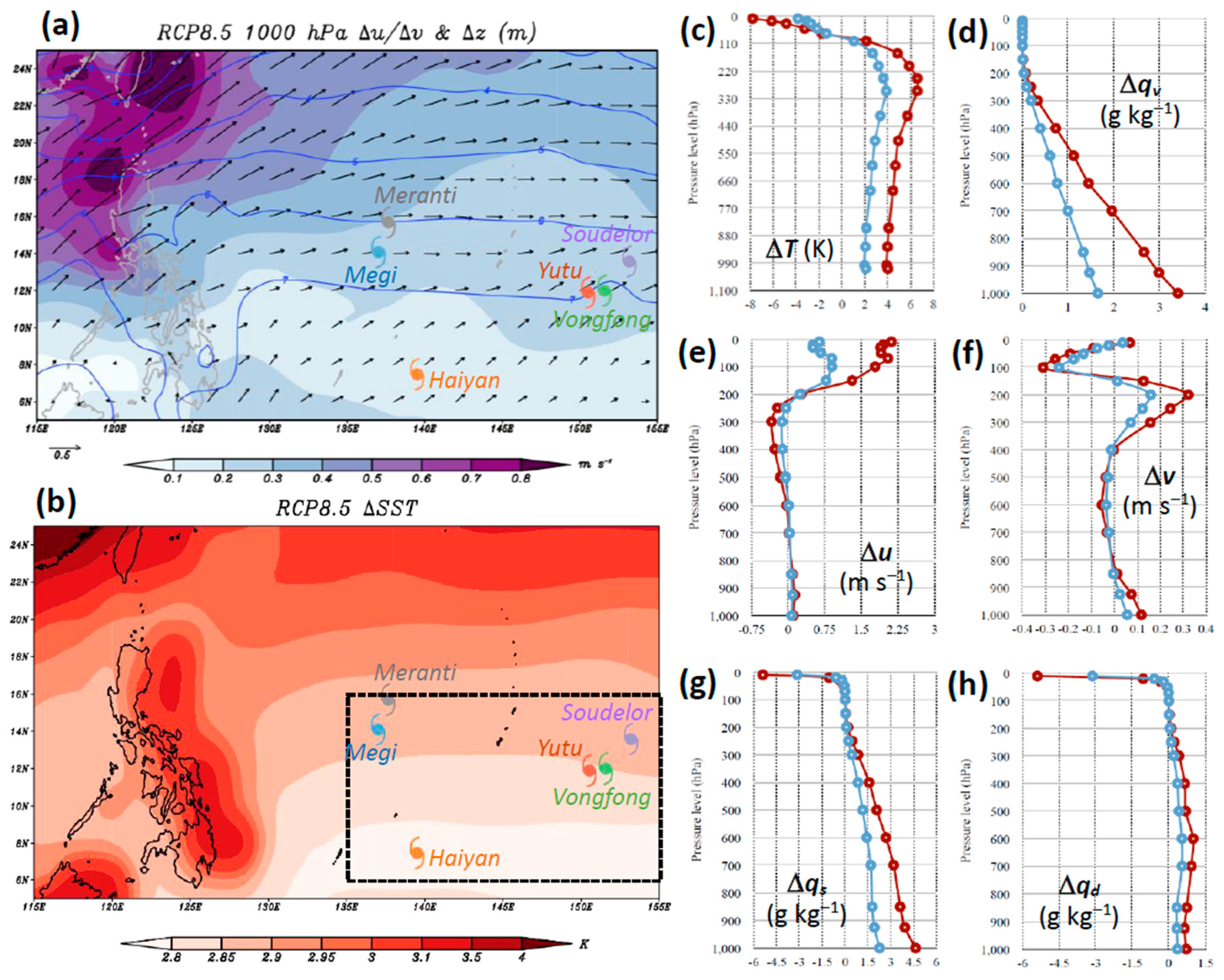

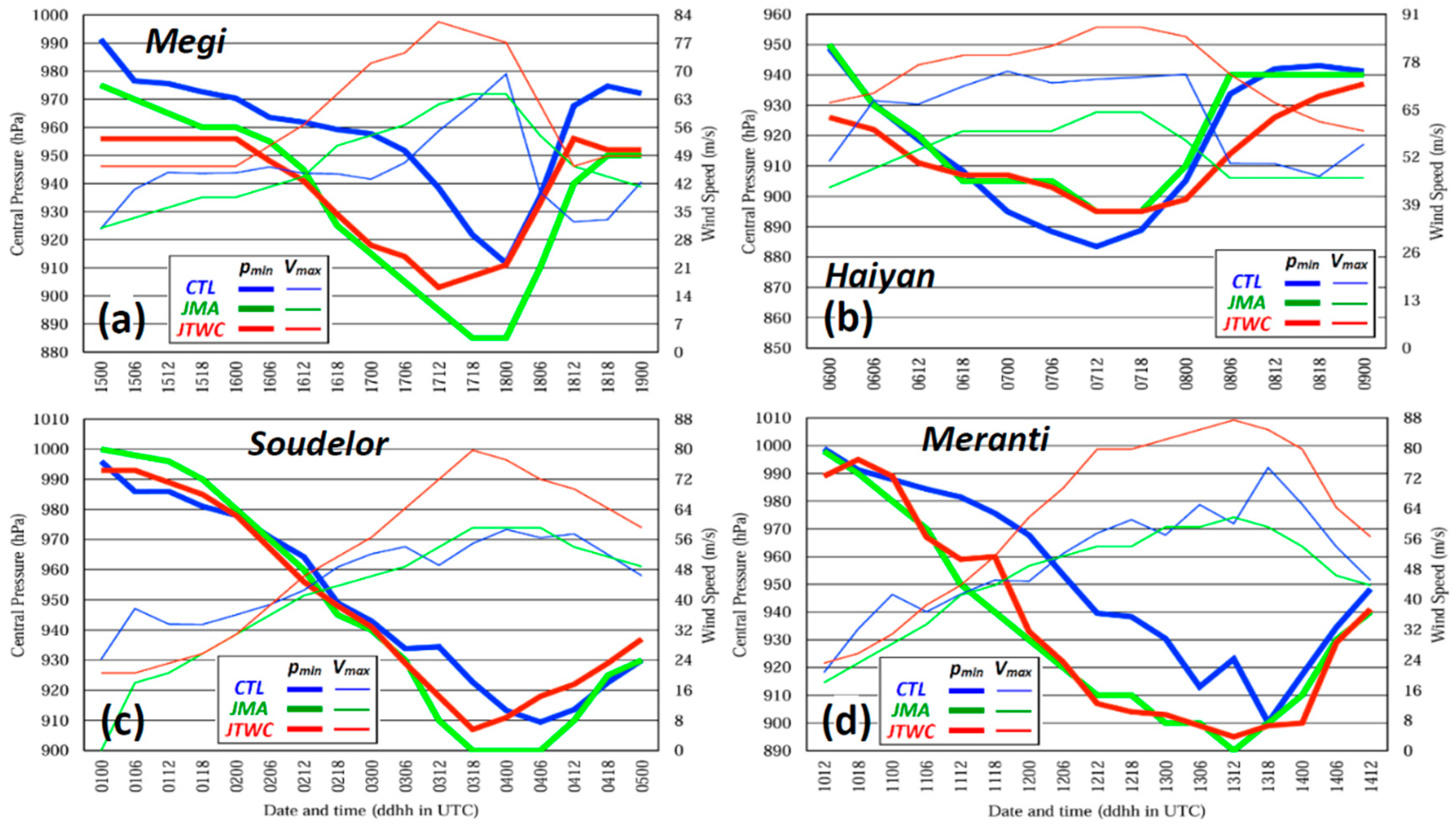
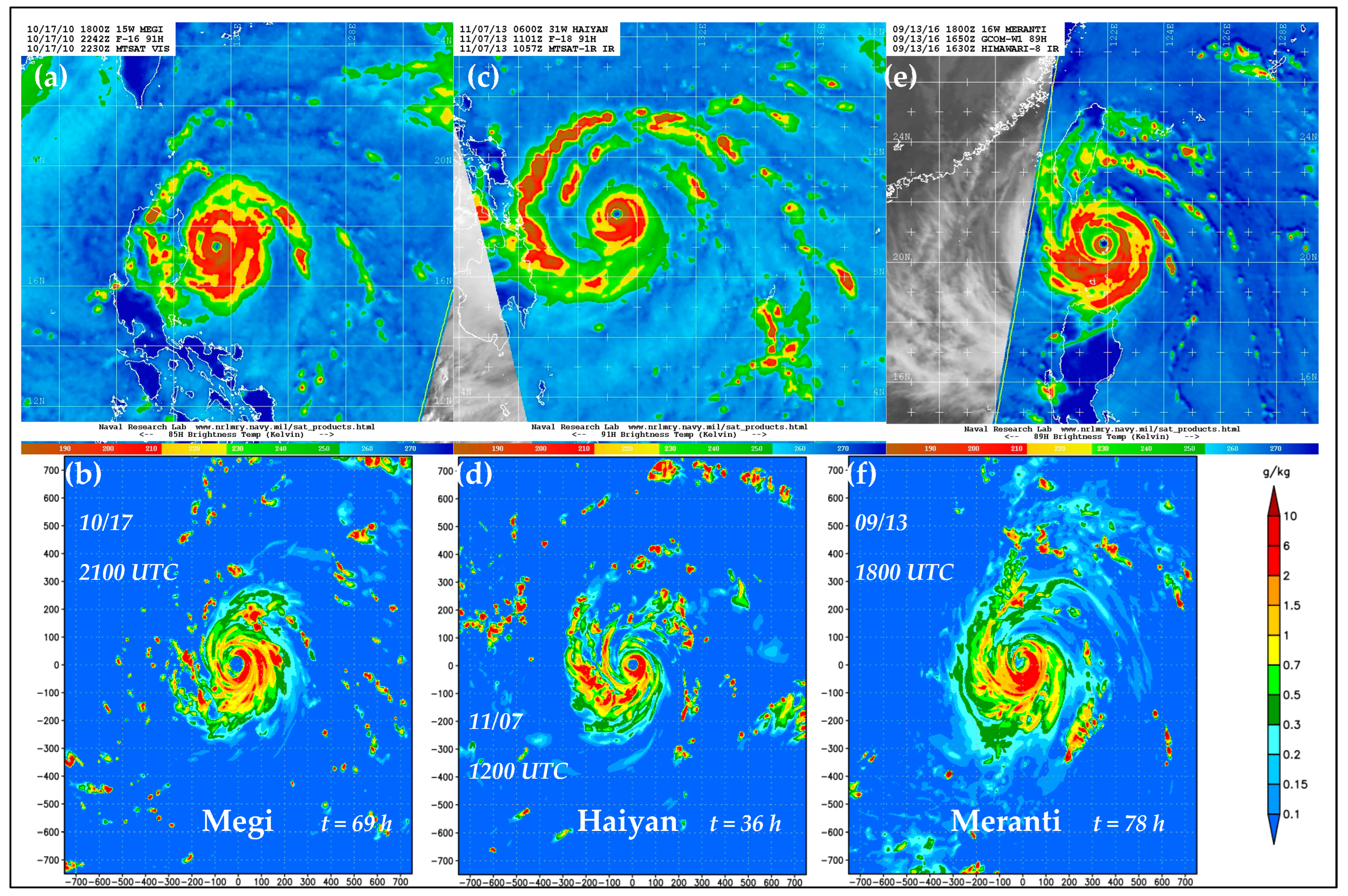
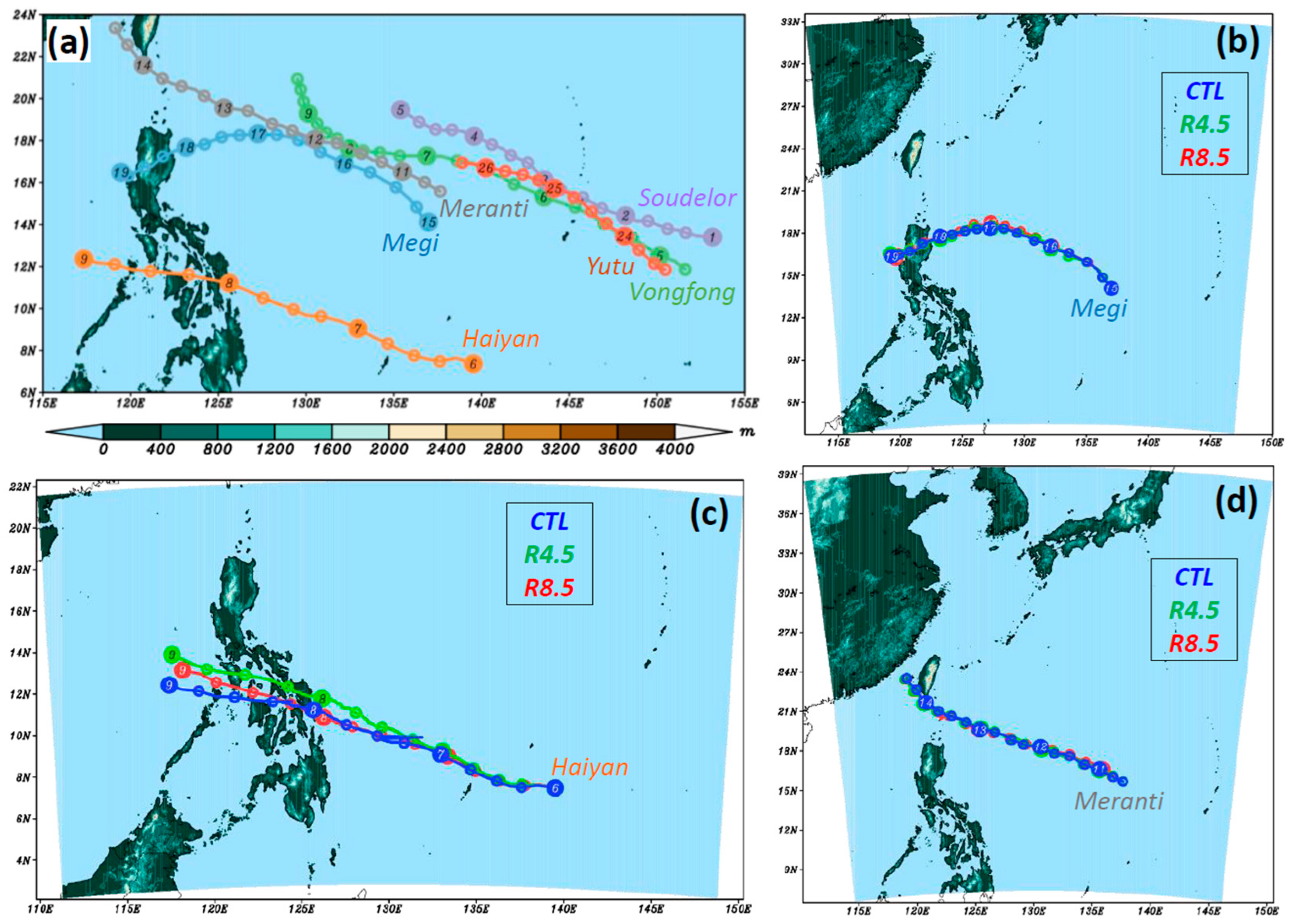


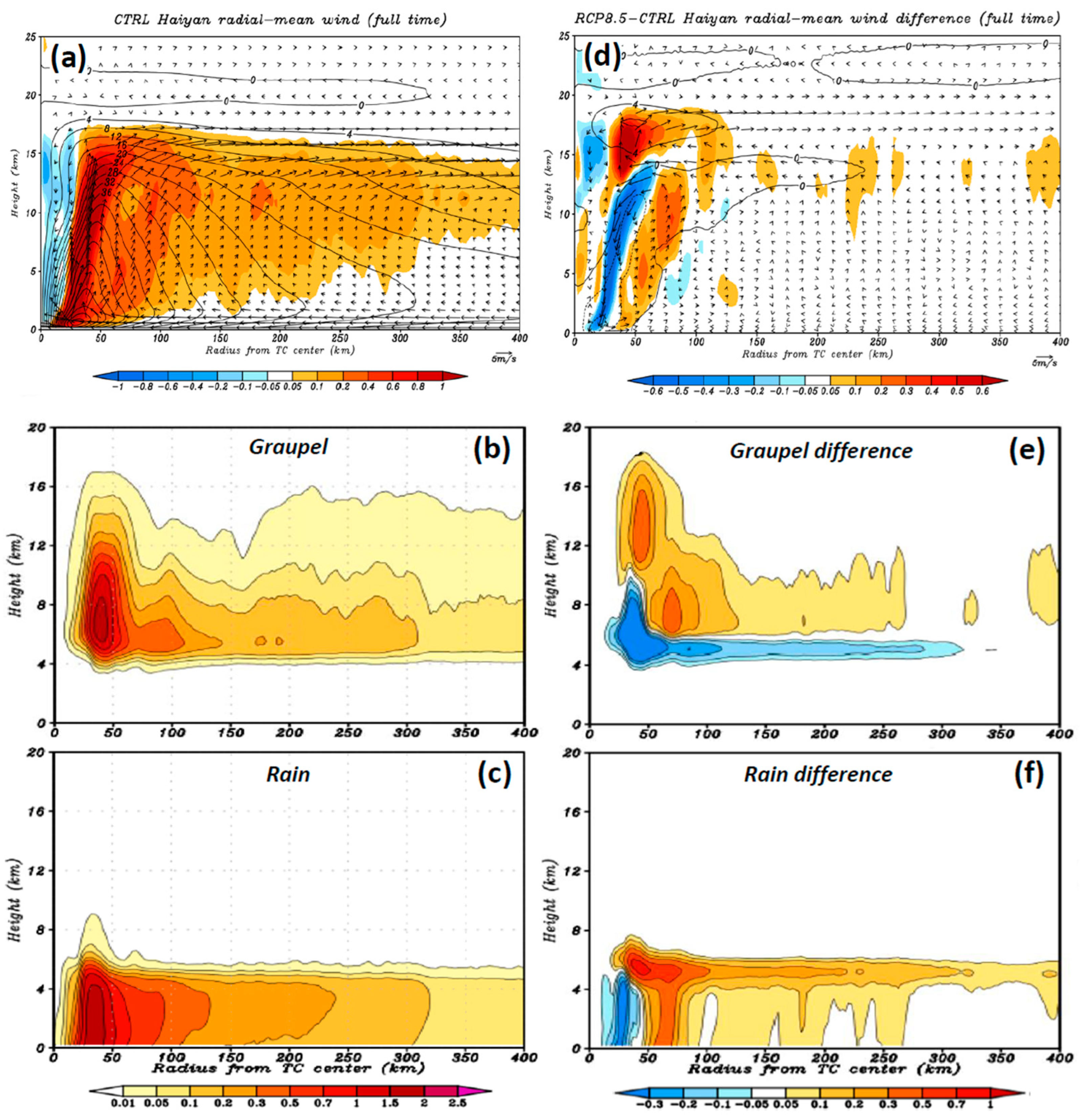
| No. | Model | Developer | No. | Model | Developer |
|---|---|---|---|---|---|
| 1 | ACCESS1.0 | CSIRO-BOM, | 21 | GISS-E2-R | NASA-GISS, USA |
| 2 | ACCESS1.3 | Australia | 22 | GISS-E2-R-CC | |
| 3 | BCC-CSM1.1 | BCC, CMA, China | 23 | HadGEM2-AO | NIMR-KMA, Korea |
| 4 | BCC-CSM1.1(m) | 24 | HadGEM2-ES | MO-HC, UK | |
| 5 | CanESM2 | CCCma, Canada | 25 | HadGEM2-CC | |
| 6 | CCSM4 | NCAR, USA | 26 | INM-CM4 | INM, Russia |
| 7 | CESM1-BGC | NSF/DOE/NCAR, | 27 | IPSL-CM5A-LR | IPSL, France |
| 8 | CESM1-CAM5 | USA | 28 | IPSL-CM5A-MR | |
| 9 | CMCC-CM | CMCC, Italy | 29 | IPSL-CM5B-LR | |
| 10 | CMCC-CMS | 30 | MIROC5 | AORI/NIES/ | |
| 11 | CNRM-CM5 | CNRM, France | JAMSTEC, Japan | ||
| 12 | CSIRO-Mk3-6-0 | CSIRO, Australia | 31 | MIROC-ESM-CHEM * | JAMSTEC, Japan |
| 13 | FGOALS-g2 | IAP-CAS, China | 32 | MIROC-ESM | |
| 14 | FGOALS-s2 | 33 | MPI-ESM-LR | MPI, Germany | |
| 15 | FIO-ESM * | FIO, SOA, China | 34 | MPI-ESM-MR | |
| 16 | GFDL-CM3 | GFDL.NOAA, USA | 35 | MRI-ESM1 | JMA-MRI, Japan |
| 17 | GFDL-ESM2G | 36 | MRI-CGCM3 | ||
| 18 | GFDL-ESM2M | 37 | NorESM1-M * | NCC, Norway | |
| 19 | GISS-E2-H | NASA-GISS, USA | 38 | NorESM1-ME | |
| 20 | GISS-E-H-CC |
| Grid spacing (x, y, z) * | 2.5 km × 2.5 km × 124–655 m (500 m) |
| Grid dimension | 1440 × 1440 × 60 (for Meranti) |
| Domain size (km) | 3660 × 3660 × 30 (for Meranti) |
| IC/BCs of atmosphere | NCEP FNL analyses (every 0.25° or 0.5°, 26 levels) |
| Sea surface temperature | HYCOM + NCODA (every 0.08°) |
| Cloud microphysics | Double-moment bulk cold-rain scheme (six species) |
| PBL turbulence | 1.5-order closure with turbulent kinetic energy prediction |
| Surface processes | Momentum/energy fluxes and shortwave/longwave radiation |
| Upper ocean | 1D slab model from 0 to 150 m in depth (60 levels) |
| Typhoon | Grid Dimension (x, y) | Initial Time and Simulation Length |
|---|---|---|
| Megi (2010) | 1440 × 1296 | 0000 UTC 15 October 2010, 96 h |
| Haiyan (2013) | 1680 × 864 | 0000 UTC 6 November 2013, 72 h |
| Vongfong (2014) | 1440 × 1440 | 1800 UTC 4 October 2014, 120 h |
| Soudelor (2015) | 1824 × 1072 | 0000 UTC 1 August 2015, 96 h |
| Meranti (2016) | 1440 × 1440 | 1200 UTC 10 September 2016, 96 h |
| Yutu (2018) | 1728 × 928 | 0600 UTC, 23 October 2018, 72 h |
| Typhoon | Minimum Pressure (hPa) | Maximum Wind Speed (m s−1) | ||||||
|---|---|---|---|---|---|---|---|---|
| JTWC | CTL | R4.5 | R8.5 | JTWC | CTL | R4.5 | R8.5 | |
| Megi (2010) | 903.0 | 911.6 | 912.1 | 910.7 | 82.31 | 69.27 | 68.08 | 71.39 |
| Haiyan (2013) | 895.0 | 883.4 | 894.0 | 910.2 | 87.46 | 77.23 | 75.15 | 70.12 |
| Vongfong (2014) | 907.0 | 915.4 | 917.4 | 919.2 | 79.74 | 58.93 | 58.21 | 58.39 |
| Soudelor (2015) | 907.0 | 907.8 | 910.3 | 919.6 | 79.74 | 60.53 | 58.50 | 60.73 |
| Meranti (2016) | 895.0 | 900.1 | 903.4 | 905.7 | 87.46 | 74.87 | 69.43 | 67.64 |
| Yutu (2018) | 904.0 | 917.7 | 920.5 | 922.2 | 77.17 | 62.83 | 64.49 | 60.55 |
| Typhoon | Exp. | 200 km | 250 km | 300 km | 350 km | 400 km | |||||
|---|---|---|---|---|---|---|---|---|---|---|---|
| Rain | Ch. | Rain | Ch. | Rain | Ch. | Rain | Ch. | Rain | Ch. | ||
| Megi (2010) | CTL R4.5 R8.5 | 20.58 22.85 24.70 | − +11.00 +19.99 | 16.47 17.84 19.37 | − +8.33 +17.58 | 13.22 14.07 15.29 | − +6.43 +15.64 | 10.66 11.32 12.14 | − +6.17 +13.90 | 8.70 9.23 9.82 | − +6.04 +12.85 |
| Haiyan (2013) | CTL R4.5 R8.5 | 26.19 28.91 31.27 | − +10.42 +19.43 | 20.49 22.00 24.82 | − +7.4 +21.16 | 16.21 17.40 19.93 | − +7.36 +23.00 | 13.18 14.43 16.59 | − +9.51 +21.84 | 11.04 12.46 14.31 | − +12.85 +29.60 |
| Vongfong (2014) | CTL R4.5 R8.5 | 21.19 22.81 26.21 | − +7.62 +23.70 | 16.66 18.00 18.80 | − +8.10 +12.86 | 13.86 14.62 14.08 | − +5.52 +1.61 | 11.55 11.76 10.81 | − +1.87 −6.40 | 9.50 9.44 8.51 | − −0.71 −10.40 |
| Soudelor (2015) | CTL R4.5 R8.5 | 15.59 17.46 19.32 | − +11.98 +23.90 | 12.80 14.04 15.27 | − +9.63 +19.28 | 10.85 11.56 12.08 | − +6.58 +11.29 | 9.16 9.48 9.73 | − +3.43 +6.24 | 7.74 7.97 8.14 | − +3.00 +5.15 |
| Meranti (2016) | CTL R4.5 R8.5 | 20.14 21.33 24.09 | − +5.92 +19.58 | 15.81 16.72 18.60 | − +5.75 +17.65 | 13.03 13.50 15.07 | − +3.64 +15.66 | 10.56 11.05 11.79 | − +4.67 +11.67 | 8.73 9.13 9.28 | − +4.63 +6.30 |
| Yutu (2018) | CTL R4.5 R8.5 | 24.11 25.81 26.85 | − +7.06 +11.37 | 19.18 19.97 20.90 | − +4.13 +8.98 | 15.44 15.81 15.86 | − +2.41 +2.76 | 12.06 12.22 11.92 | − +1.35 −1.15 | 9.49 9.54 9.31 | − +0.61 −1.82 |
| Typhoon | n | Experiment | 200 km | 250 km | 300 km | 350 km | 400 km |
|---|---|---|---|---|---|---|---|
| Megi (2010) | 32 | R4.5—CTL R8.5—CTL | 5.183 7.700 | 6.249 8.432 | 5.100 8.646 | 4.306 7.443 | 4.805 6.761 |
| Haiyan (2013) | 24 | R4.5—CTL R8.5—CTL | 4.298 5.158 | 3.084 6.146 | 3.240 7.067 | 4.586 8.169 | 5.746 9.810 |
| Meranti (2016) | 32 | R4.5—CTL R8.5—CTL | 3.951 5.799 | 3.859 5.450 | 2.207 5.290 | 2.842 3.945 | 2.585 2.359 |
| Confidence level | 90.0% | 95.0% | 99.0% | 99.5% | 99.9% | ||
| n = 24 | 1.320 | 1.714 | 2.500 | 2.807 | 3.485 | ||
| n = 32 | 1.309 | 1.696 | 2.453 | 2.744 | 3.375 |
| Typhoon | Experiment | P | TDC | CVF | CONV | ADV | CHF | E | R |
|---|---|---|---|---|---|---|---|---|---|
| Megi (2010) (r = 350 km) (t = 6–90 h) | CTL R4.5 R8.5 | 10.79 11.48 12.47 | 0.21 0.25 0.29 | 9.48 10.37 11.31 | 10.58 11.45 12.50 | −1.10 −1.07 −1.19 | −0.08 −0.06 −0.06 | 1.41 1.46 1.54 | +0.19 −0.04 −0.02 |
| R4.5—CTL R8.5—CTL | +0.69 +1.68 | +0.04 +0.08 | +0.89 +1.83 | +0.87 +1.93 | +0.03 −0.09 | +0.02 +0.02 | +0.05 +0.13 | − − | |
| Haiyan (2013) (r = 250 km) (t = 24–72 h) | CTL R4.5 R8.5 | 19.16 21.48 23.75 | 0.15 0.19 0.29 | 15.85 17.05 19.24 | 17.19 18.44 20.82 | −1.34 −1.38 −1.58 | +0.10 +0.07 +0.21 | 1.80 1.84 2.03 | +1.57 +2.70 +2.57 |
| R4.5—CTL R8.5—CTL | +2.32 +4.59 | +0.04 +0.14 | +1.20 +3.39 | +1.25 +3.63 | −0.04 −0.24 | −0.03 +0.11 | +0.04 +0.23 | − − | |
| Meranti (2016) (r = 300 km) (t = 6–90 h) | CTL R4.5 R8.5 | 13.36 14.03 15.49 | 0.13 0.15 0.24 | 11.15 12.54 15.75 | 12.35 13.82 17.32 | −1.21 −1.28 −1.58 | +0.12 +0.11 −0.03 | 1.52 1.59 1.56 | +0.70 −0.06 −1.55 |
| R4.5—CTL R8.5—CTL | +0.67 +2.13 | +0.02 +0.11 | +1.39 +4.60 | +1.46 +4.97 | −0.07 −0.37 | −0.01 −0.15 | +0.07 +0.03 | − − |
| Typhoon | Experiment | CONV | PW5.5 | IHC5.5 | |||
|---|---|---|---|---|---|---|---|
| Megi (2010) | CTL | 10.58 | 53.11 | 5.45 | |||
| (r = 350 km) (t = 6–90 h) | R4.5—CTL R8.5—CTL | +0.87 +1.93 | +8.2% +18.2% | +6.78 +12.66 | +12.8% +23.8% | −0.17 −0.08 | −3.0% −1.5% |
| Haiyan (2013) | CTL | 17.19 | 53.11 | 10.29 | |||
| (r = 250 km) (t = 24–72 h) | R4.5—CTL R8.5—CTL | +1.25 +3.63 | +7.3% +21.1% | +7.04 +13.26 | +13.3% +25.0% | −0.51 +0.08 | −5.0% +0.7% |
| Meranti (2016) | CTL | 12.35 | 54.39 | 7.64 | |||
| (r = 300 km) (t = 6–90 h) | R4.5—CTL R8.5—CTL | +1.46 +4.97 | +11.9% +40.2% | +7.12 +14.15 | +13.0% +25.8% | −0.01 +0.64 | −0.2% +8.4% |
| Experiment | Δ Values for RCP8.5 | Minimum Pressure (pmin, hPa) | ||||
|---|---|---|---|---|---|---|
| u/v | z/T/SST | qv | Haiyan | Megi | Meranti | |
| CTL R8.5 | √ | √ | √ | 883.4 910.2 | 911.6 910.7 | 900.1 905.7 |
| R8.5_nW R8.5_nQ R8.5_nWQ | √ | √ √ √ | √ | 909.5 911.9 900.3 | 910.4 928.3 931.6 | 905.1 907.6 909.2 |
| R8.5_nWT R8.5_cQd | √ | √ | √ cQd | 926.3 905.2 | − − | − − |
Disclaimer/Publisher’s Note: The statements, opinions and data contained in all publications are solely those of the individual author(s) and contributor(s) and not of MDPI and/or the editor(s). MDPI and/or the editor(s) disclaim responsibility for any injury to people or property resulting from any ideas, methods, instructions or products referred to in the content. |
© 2024 by the authors. Licensee MDPI, Basel, Switzerland. This article is an open access article distributed under the terms and conditions of the Creative Commons Attribution (CC BY) license (https://creativecommons.org/licenses/by/4.0/).
Share and Cite
Wang, C.-C.; Hsieh, M.-R.; Thean, Y.T.; Zheng, Z.-W.; Huang, S.-Y.; Tsuboki, K. Potential Impacts of Future Climate Change on Super-Typhoons in the Western North Pacific: Cloud-Resolving Case Studies Using Pseudo-Global Warming Experiments. Atmosphere 2024, 15, 1029. https://doi.org/10.3390/atmos15091029
Wang C-C, Hsieh M-R, Thean YT, Zheng Z-W, Huang S-Y, Tsuboki K. Potential Impacts of Future Climate Change on Super-Typhoons in the Western North Pacific: Cloud-Resolving Case Studies Using Pseudo-Global Warming Experiments. Atmosphere. 2024; 15(9):1029. https://doi.org/10.3390/atmos15091029
Chicago/Turabian StyleWang, Chung-Chieh, Min-Ru Hsieh, Yi Ting Thean, Zhe-Wen Zheng, Shin-Yi Huang, and Kazuhisa Tsuboki. 2024. "Potential Impacts of Future Climate Change on Super-Typhoons in the Western North Pacific: Cloud-Resolving Case Studies Using Pseudo-Global Warming Experiments" Atmosphere 15, no. 9: 1029. https://doi.org/10.3390/atmos15091029





